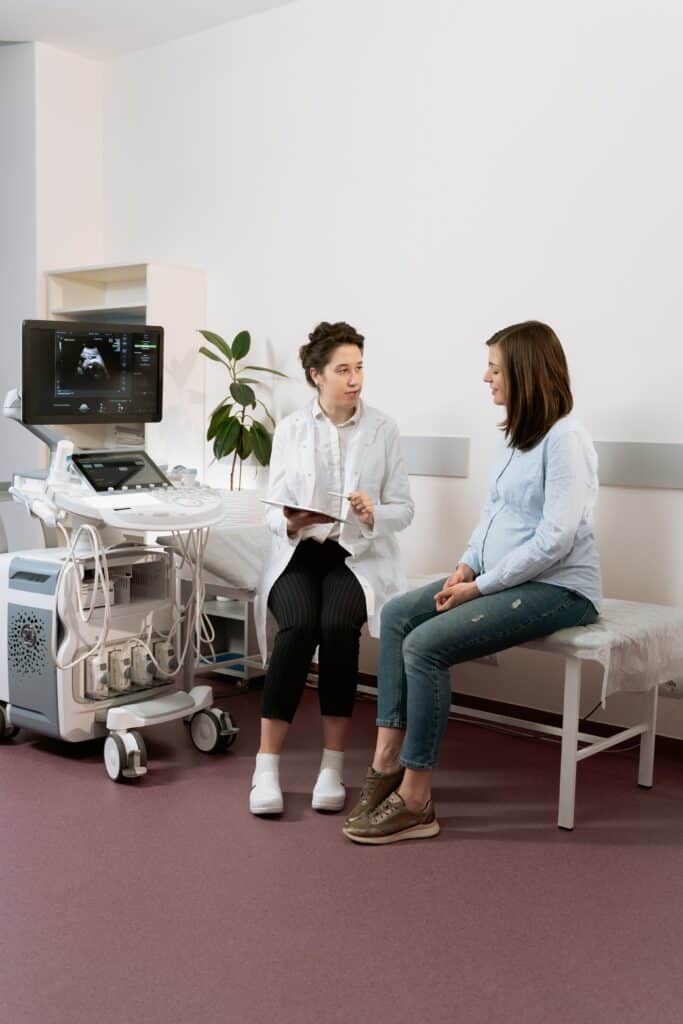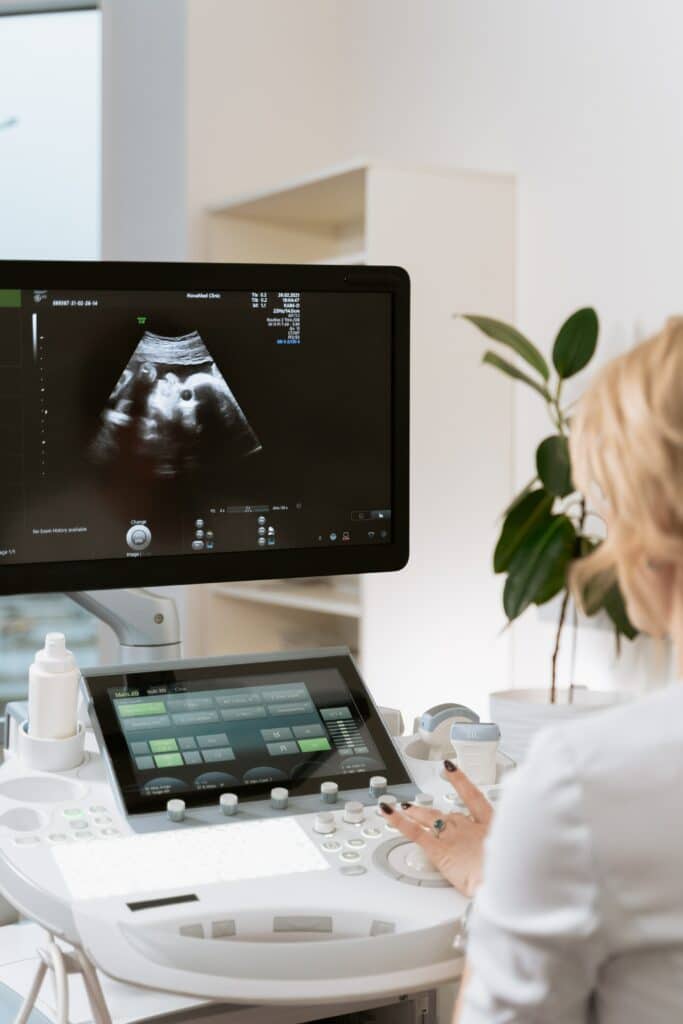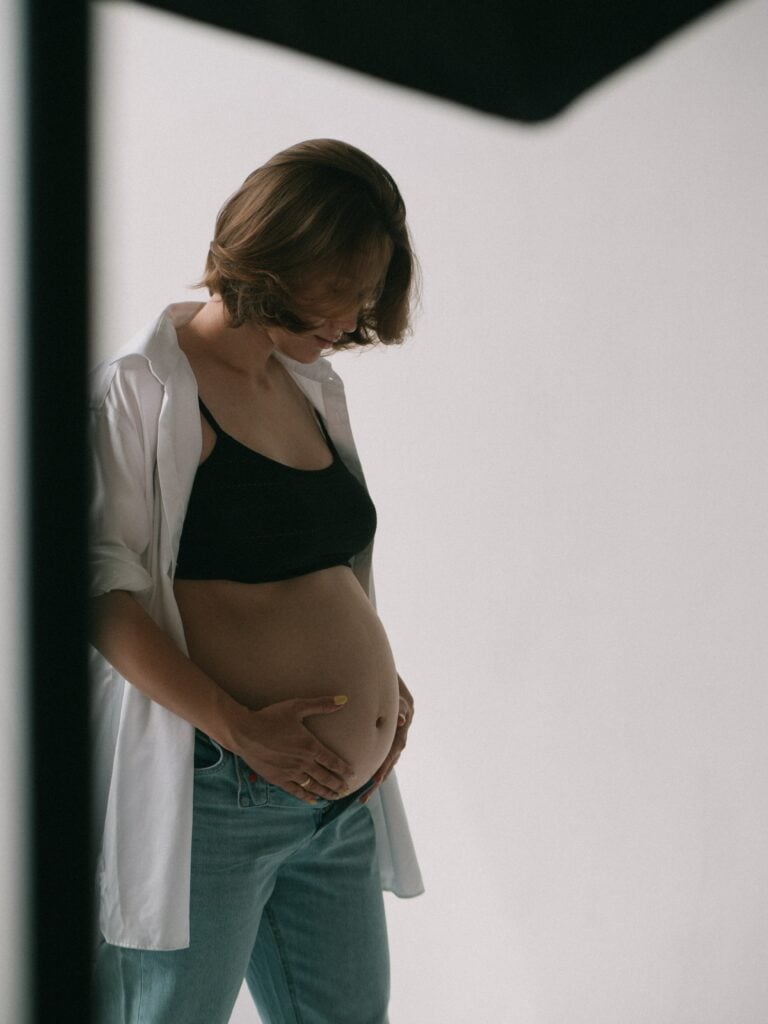It is exciting to get to go to your first prenatal and ultrasound appointments. You’re anxious to hear the heartbeat and see how the baby is doing, but it can be difficult to know what to wear to prenatal appointments if you’re not sure what’s going to happen!
Wearing a two-piece outfit is your best bet for either an obstetrical doctor’s appointment or ultrasound. This will ensure you will be able to lift your shirt to expose your tummy if needed or give you the option to just unrobe from the waist down if necessary. Avoid dresses and jumpsuits if you expect that you will need to expose just your belly.
Read on to see what to expect from your prenatal appointments and also what kind (and how many) ultrasounds you are likely to get.

Table of Contents
What to wear to prenatal appointments or ultrasounds
The best thing to wear for either a prenatal appointment or an ultrasound is a comfortable, stretchy two-piece outfit.
If you do have to undress, it’s usually just from the waist down and you will be able to keep your shirt on.
If you don’t have to undress for a pelvic check or a vaginal ultrasound, you will need to be able to have your belly easily accessible as your doctor will need to palpate your abdomen and scan the fetal heart rate.
Transabdominal ultrasounds will also need access to your belly as well. Wearing a two-piece outfit enables you to easily lift your shirt as needed, which can be challenging with a one-piece outfit like a jumpsuit.
Dresses can be the easiest go-to outfit during pregnancy, but they can be a little weird at your appointments. You’ll either need to hike it all the way up to your armpits or wear an exam gown.
What happens during prenatal appointments?
Prenatal visits are the best way to keep an eye on the health of both your and your unborn baby. As your pregnancy progresses, you will visit your doctor or midwife more frequently, but the exams will be fairly standard.
Expect to give a urine sample at each visit as well as have your blood pressure checked and weight taken.
The first visit will be the most comprehensive as a complete medical history, family history, and genetic health assessment will be taken as well as a pelvic exam to check for anything that could hurt the baby. You will also have prenatal labs drawn at this time.
Subsequent visits will consist of your doctor checking your baby’s heart rate, continuing to measure vital signs and urine, as well as measuring the fundal height of your uterus to ensure your baby is growing as expected. You will also be checked for gestational diabetes around week 28 and will have the option to partake in genetic testing if so desired around week 12.
Do you have to take your clothes off at prenatal appointments?
The first prenatal appointment for new moms can be stressful and exciting, but you can make it a little easier on yourself by being mentally and sartorially prepared.
During your first prenatal appointment, your doctor may ask to perform a cervical check to look for any abnormalities. During your last few weeks, you’ll also have the option for an internal exam to check for dilation.
Remember, pelvic exams are always optional and you do not have to consent to one if it doesn’t fit into your care goals.
The rest of your OB appointments will consist mainly of your doctor scanning your belly with a Doppler machine to check the baby’s heart rate and him or her feeling around on top of your belly to check your uterus and baby.
At these appointments, you will only have to raise your shirt enough to expose your belly and may have to slightly lower your pants.
Dressing for a prenatal appointment
Generally speaking, you will visit your OB/GYN or midwife once every four weeks up to week 28. From week 28 to week 36 you see your doctor every 2 weeks, then from week 36 on begin to see your doctor weekly.
Wearing a two-piece outfit is ideal for any prenatal appointment as you will need to expose either your belly or your pelvis depending on the scheduled exam.
At the very first appointment, then later towards the end of your pregnancy, your doctor might offer the option to have pelvic exams. If you want to do this, you’ll need to be prepared to undress at least from the waist down on these visits.
The appointments in the middle of pregnancy typically consist of your doctor listening to the baby’s heartbeat with a Doppler machine that is scanned over the belly as well as feeling around on top of the abdomen so you will need to be able to raise your shirt up for these appointments.

What to wear for a prenatal appointment
Wear a two-piece outfit to your prenatal appointments.
A skirt or a pair of comfortable pants with a t-shirt or button-down shirt is perfect as you will be able to remove the article of clothing easily and redress quickly once the exam is finished.
A lot of the time you will only have to raise your shirt to grant your doctor access to your belly. This can be awkward to do if wearing a dress or other one-piece outfit.
It’s a good idea to wear something that washes well. The jelly that the technician uses for the ultrasound and Doppler can get on your clothes.
What not to wear for a prenatal appointment
Although many expectant moms choose to spend the later months of their pregnancy in loose, comfortable dresses, they are not especially practical for appointment days.
Avoid wearing dresses, rompers, jumpsuits, or any other one-piece attire as they will guarantee you will have to change into a hospital gown.
If you must wear a dress, wearing leggings underneath will afford you a little more privacy.
Also, if you like to use kinesiology tape on your belly, it’s a good idea to leave it off until after your appointment so you don’t have to redo it at the office.
What happens during an ultrasound?
When you’re pregnant, the only imaging modality safe to look at your unborn baby is an ultrasound. Ultrasounds use sound waves, not radiation, to create images by using a transducer that can be either gently placed on top of your abdomen (transabdominal ultrasound) or placed into the vagina (pelvic ultrasound) to obtain images.
How many ultrasounds you will receive during your pregnancy depends on a few factors such as your doctor’s preference and the health of you and your child. Most healthy pregnancies only require two ultrasounds, one in the first trimester to determine the due date and one at around 20 weeks (also called an anatomy scan) to check and measure all the baby’s internal organs and to determine the sex.
If you are having a high-risk pregnancy, have blood pressure issues or preeclampsia, your baby has a known genetic disorder, or if there were any abnormalities on the anatomy scan your doctor will order additional ultrasounds to check on your baby’s progress.
8-week ultrasound
The first ultrasound is typically done in the first trimester after the six-week mark.
Since the baby’s heartbeat can’t always be heard before six weeks you more than likely won’t have a scan before then. The first ultrasound will be a pelvic ultrasound, meaning the ultrasound probe will be inserted into the vagina to scan your uterus and fetus because it can better detect early pregnancies.
You will be lying on your back on a stretcher with your feet in stirrups like you do for your yearly checks. Keep in mind that during this scan your baby may not look like a typical baby during this scan. These are still early days in your pregnancy and your baby has a lot more growing and forming to do.
The doctor will be using this ultrasound to confirm that your baby’s measurements support the due date estimated by your last period and also to confirm the number of fetuses in your womb. Pregnancies with multiples often require advanced care so it’s good for your doctor to know as early as possible.
12-week ultrasound
The 12-14 week ultrasound can check on your baby’s progress as well as look for any genetic disorders. If you have opted for a genetic check, you will likely have labs drawn around this time as well.
The ultrasound tech will also check on your uterus and ovaries, the location of your placenta and umbilical cord, as well as the level of fluid around your baby. Basic baby anatomy can also be assessed around this time frame. The ultrasound tech may be able to visualize your baby transabdominally during this scan but sometimes will still have to perform it vaginally so it’s wise to be prepared for both scenarios.
Not all doctors will order this 12-week ultrasound, though. Whether you get one will be determined by your specific pregnancy, your choice in genetic testing, and your doctor’s preferences.
20-week ultrasound
The 20-week ultrasound, also known as the anatomy scan, is where all of your baby’s body parts and internal organs are checked and measured to ensure everything is forming the way it should.
Many people think of this as the gender reveal scan, but that’s not actually the purpose of this appointment.
During the anatomy scan, the ultrasound technician carefully measures your baby’s bones and limbs and takes images of the organs. These details help your doctor diagnose any health concerns for your baby before they’re born and help to prepare for a safe delivery.
Your baby will look more like a baby to you during this scan. You will be able to clearly make out his or her little hands and feet and maybe even get to glimpse a profile of their face.
Your baby will likely be moving around during this scan, especially since this scan will be done transabdominally, or over the belly. Your baby may feel a little bit of pressure from the transducer stimulating him to move around but it’s nothing that will harm him or cause discomfort.
If your baby is in the right position, the ultrasound will also reveal your baby’s genitals so that you can learn the gender. There is still a chance for error. You can also determine the baby’s gender beginning at 10 weeks with noninvasive prenatal testing.

3D ultrasound
Some parents choose to have a 3D ultrasound in addition to the standard ones.
Most 3D ultrasounds are elective procedures chosen by parents to either determine the sex of the baby before their 20-week ultrasound appointment or to obtain keepsake photos of the baby in utero as 3D images can look more like an actual baby than the traditional 2D images.
However, many doctors’ office increasingly have 3D technology that can give even low-risk patients a quick peek at their baby’s features.
Medically speaking, 3D ultrasound images can be obtained to help in determining if there are any facial abnormalities or neural tube defects. A 3D ultrasound will be obtained in the same way as a regular transabdominal ultrasound.
Do you have to take your clothes off for an ultrasound?
How much of your clothing you get to leave on for an obstetric ultrasound depends on how the ultrasound will be obtained.
Wearing a two-piece outfit would be best for days you will be having any type of ultrasound. Wearing a dress or jumpsuit would probably mean you would have to completely disrobe and put a hospital gown on.
If you are receiving a pelvic ultrasound, meaning the transducer is inserted into the vagina to obtain pictures, you will be asked to remove your pants and underwear and will be given a paper apron to cover your bottom half. Vaginal ultrasounds are usually obtained during the first trimester when the baby is very small and low in the pelvis.
If you are able to have a transabdominal ultrasound, meaning the transducer is placed over the belly, the ultrasound tech will have you raise your shirt and slightly lower your pants. A towel will be tucked in around your clothing to ensure the ultrasound gel won’t make a mess on your clothes.
Abdominal ultrasounds are usually obtained in the second and third trimesters.
Dressing for an ultrasound
Unless you have done your research (or had a baby previously), you may be surprised to find out that not all ultrasounds scan the mother’s tummy.
Wear a two-piece outfit for your prenatal ultrasound so that if you need to take pants and underwear off you don’t have to completely disrobe like you would when wearing a dress or romper.
For the average pregnancy, you can expect to have two ultrasounds.
One will likely be at your first appointment in the first trimester, or around 8 weeks, and the second will likely be at your 20-week appointment. The 8-week ultrasound will require you to remove your pants and underwear.
At the 20-week ultrasound, you typically only have to raise your shirt for the scan. However, you may also have a second vaginal ultrasound if the technician can’t get a clear image of your cervix or if there are special concerns.
What to wear for an ultrasound

While you may think about dressing specifically for your doctor’s appointments, it may not occur to you that you should do the same for your ultrasound.
Wear a two-piece outfit for your ultrasound, something comfortable that you can easily remove and quickly put back on once your ultrasound is complete. A pair of leggings or maternity jeans with a comfy t-shirt is always a solid choice.
If you have a transabdominal ultrasound you will only have to raise your shirt and lower your pants enough in the front for the tech to visualize your uterus. Towels will be tucked in around clothing to protect them from the ultrasound gel but sometimes that won’t be enough. Wear clothing that can easily be tossed in the washing machine should the gel make a mess.
If you have to have a pelvic ultrasound you will be asked to remove pants and underwear and will be given a paper drape to place over your lap. Wearing a two-piece outfit ensures you won’t have to remove your shirt as well.
What not to wear for an ultrasound
Wearing a comfortable two-piece outfit ensures you can keep as much of your dignity intact as possible, but there are a couple of things you definitely shouldn’t wear to an ultrasound.
While you may have a whole closet full of cute maternity dresses to wear, abstain from wearing one to your ultrasound appointment. Rompers or jumpsuits would also be an unwise clothing choice as you would have to completely disrobe and wear a hospital gown during your appointment.
You should also avoid wearing anything too snug, difficult to get into/out of, or anything particularly nice as you may get some ultrasound gel on it.
Conclusion
You’ll be in and out of the doctor’s office a lot during your pregnancy. You can make those appointments a little quicker and easier for yourself by planning ahead and wearing clothes that accommodate your exam type.
When in doubt, always try to wear a two-piece outfit that washes well and is easy to get in and out of.










